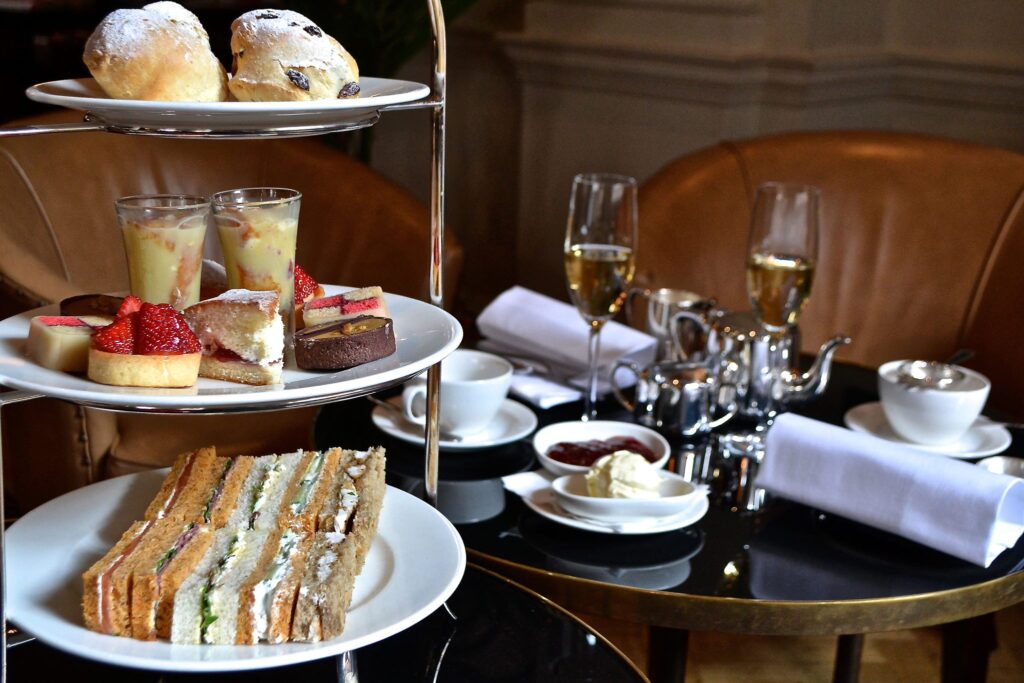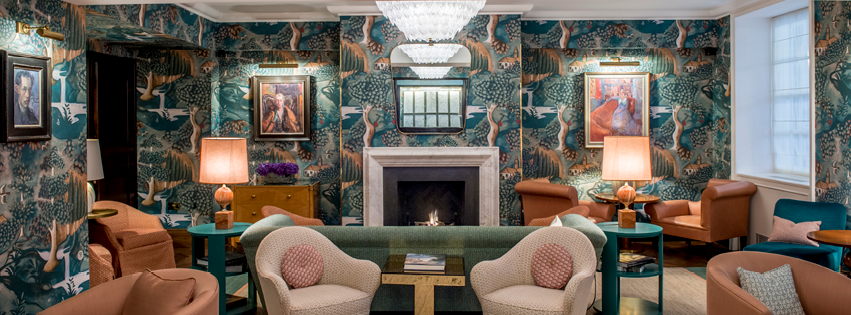A Lutyens-designed hotel in the world in London’s literary heartland
LONDON, ENGLAND – A 1928 Grade-II listed building designed by Sir Edwin Lutyens as a YWCA Central Club on Great Russell Street in London, The Bloomsbury showcases the ultimate in hotel design. The hotel has been transformed following a multimillion-pound investment program in collaboration with internationally acclaimed Martin Brudnizki Design Studio.
The project involved the redesign of the public space on the main floor. The original flight of Portland Stone steps leads into a new reception area, an intimate space with a beautiful Lutyens-inspired Living Room for the exclusive use of guests. A color palette of muted greens and pinks is accented with an electric mix of furnishings, artwork and lighting, as well as eye catching, heritage-inspired botanical wallpaper and a fireplace also designed by Lutyens.
Nearby the magnificent Coral Room bar has been sensitively reimagined. The refurbishment is the final chapter of the wider restoration of The Bloomsbury, following the very successful launches of the award-winning Dalloway Terrace and The Bloomsbury Club Bar, which were added to the property in 2016 along with the refurbishment of 11 suites.
Coinciding with the changes at the hotel, the Bloomsbury borough is itself experiencing a transformation, not seen since the heady days of “The Bloomsbury Set” – a group of influential English writers, intellectuals, philosophers and artists whose work deeply influenced literature, aesthetics, criticism and economics. The group, which included Virginia Woolf, John Maynard Keynes, E.M. Forster and Lytton Strachey, all lived, worked or studied together in Bloomsbury. They were united by an abiding belief in the importance of the arts, and the neighborhood is going back to its roots, attracting a modern-day Bloomsbury set, as access to the area rapidly increases with the arrival of Crossrail in fall 2021, making the journey to and from Heathrow and other parts of London even more accessible. In addition, the neighboring British Museum has plans to open three new galleries. However, what continues to make Bloomsbury such a timeless hidden London gem is its elegant garden squares and streets that are lined with an eclectic selection of shops and boutiques.
Rooms & Suites: The same blend of historical charm and contemporary chic that defines the aesthetic of the hotel’s public space also runs through its rooms. An understated décor is blended with period architectural details. Design touches Italian marble bathrooms give a classic feel with a dash of modern flair. The Classic rooms overlook Bloomsbury’s history-laden streets and rooftops, or the hotel’s quiet central courtyard. The heritage feel of each room is counter-balanced by statement lighting velvet armchairs and chic décor that s enlivened by bold contemporary fabrics referencing Edwin Lutyens’ favored black-and-white aesthetic. Luxury Studio Suites are positioned on corners for added space, light and views, and they feature statement wallpaper, lantern lampshades and vintage-style upholstery for a homey feel. Earthy, natural tones lend a sense of calm and space.
Bar & Dining News: Dalloway Terrace, named for Mrs. Dalloway in the Virginia Woolf novel, is an elegant, poetic and quintessentially English space. Fully heated, this year-round destination restaurant and bar offers the peace and charm of a secluded secret garden in the winter, and a light, elegant and beautiful al fresco space in the spring and summer months. Light breakfasts, brunch, afternoon tea and all-day favorites make up the Dalloway Terrace menu, with a range of cocktails and wines also available.
The vibrant new Coral Room is inspired by the 1920s and has been designed in collaboration with Martin Brudnizki. The original paneled walls were retained and given a high-gloss lacquer finish in vivid coral, a favorite color of Lutyens. Five bespoke Murano glass chandeliers were specially created for the space and British illustrator Luke Edward Hall created 36 original pieces of art inspired by the surrounding Bloomsbury area and the Lutyens architecture. The bar itself features a Calacatta marble top with a high-gloss molded timber front, and the back bar features antique mirror and brass detailing to reflect the hotel’s heritage.
The Bloomsbury Club Bar is inspired by the lives of the famously hedonistic Bloomsbury Set. Channeling the 1920s and 1930s, the bar menu celebrates the golden age of cocktails with a strong, seductive mix of forgotten classics and innovative new creations inspired by the Bloomsbury Set’s infamous members.
Meetings & Events: Complementing the grandeur of The Bloomsbury is its broad range of meeting and event spaces. The expansive George V and Queen Mary Halls are stately ballrooms with lofty ceilings and Waterford crystal chandeliers, while the double-height, Lutyens-designed Chapel and the book-lined Seamus Heaney Library – named for the late Nobel Laureate and former regular guest – offer more intimate event spaces with real character.

